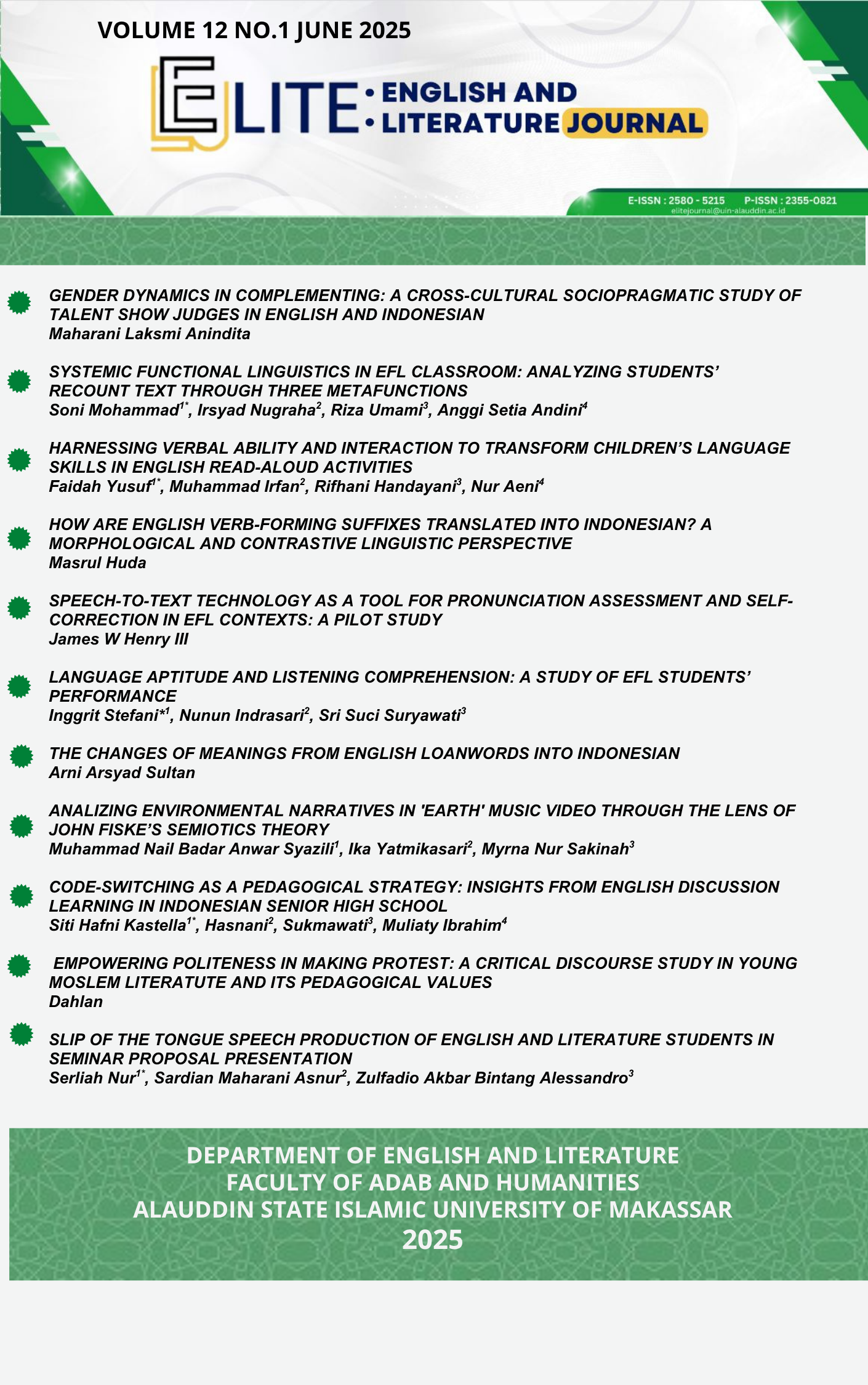ANALIZING ENVIRONMENTAL NARRATIVES IN 'EARTH' MUSIC VIDEO THROUGH THE LENS OF JOHN FISKE’S SEMIOTICS THEORY
Keywords:
Semiotics, Music video, Lil DickyAbstract
This study explores how environmental messages are constructed and conveyed through the music video Earth by Lil Dicky, analyzed using Fiske’s (1987) semiotic theory. Through the three levels of semiotic analysis namely reality, representation, and ideology, this study explains how verbal and visual signs in the music video work together to form meaningful messages related to environmental issues. Using a qualitative descriptive approach, this study analyzes selected segments of the video that depict environmental problems such as ecological damage and human negligence. The findings reveal that the video utilizes symbolic representations—including animated characters, color schemes, camera angles, and lyrical expressions—to convey themes of conservationism, anthropocentrism, and global collectivism. The song “Earth” serves not only as entertainment but also as a medium to raise awareness about the global environmental crisis and the urgency of collective action. This study contributes to the field of linguistics, particularly semiotic studies, by demonstrating how environmentally themed messages can be communicated through popular media.
Downloads
References
Agnes, L. L., & Loisa, R. (2019). Representasi Gay Melalui Penggunaan Warna (Analisis Semiotika Video Klip Color Mnek). Koneksi, 2(2), 417. https://doi.org/10.24912/kn.v2i2.3918
Amaral, A. C. A. (2018). Budaya Indonesia dalam video klip Coldplay “Amazing Day” (Analisis semiotika Roland Barthes). JISIP: Jurnal Ilmu Sosial Dan Ilmu Politik. https://doi.org/10.33366/jisip.v8i1.1599
Asrita. (2020). Representasi Lgbt Dalam Video Klip “Too Good At Goodbyes”. Jurnal Komunikasi Dan Kajian Media.
Beck, U. (1992). Risk society: Towards a new modernity. Sage Publications.
Bordwell, D., & Thompson, K. (2008). Film art: An introduction. McGraw-Hill Higher Education.
Chandler, D. (2004). Semiotics: The Basics (2nd ed.). Routledge. https://doi.org/10.4324/9780203014936
Christanto, J. (2014). Ruang Lingkup Konservasi Sumber Daya Alam dan Lingkungan.
Creswell, J. W. (2013). Research Design: Qualitative, Quantitative, and Mixed Methods Approaches (4th ed.). SAGE Publications.
Faizah, D. A. (2024). Representasi alam dan lingkungan pada cerita Jagapati Bumi sebagai media edukasi ekologis bagi remaja. GHANCARAN: Jurnal Pendidikan Bahasa Dan Sastra Indonesia. https://doi.org/10.19105/ghancaran.vi.17248
Fiske, J. (1987). Television culture. Routledge. https://doi.org/10.4324/9780203133446
Fiske, J. (1990). Introduction to Communication Studies (2nd ed.). Routledge. https://doi.org/10.4324/9780203134313.
Giannetti, L. (2014). Understanding Movies (13th Edition ed.). Pearson Education, Inc.
Hall, S. (1980). Encoding/Decoding. In D.H Stuart Hall (Ed.), Culture, Media, Language. In Encoding/Decoding. In D.H Stuart Hall (Ed.), Culture, Media, Language (128-138). New York: Routledge.
Halliday, M. A. K., & Matthiessen, C. (2014). Halliday’s Introduction to Functional Grammar (4th ed.). Oxon: Routledge.
Juliani, R. (2019). Kampanye Lgbt Di Media Sosial Facebook Dan Whatsapp. Jurnal Ilmu Komunikasi, 4(2), 29–44. https://doi.org/10.35308/source.v4i2.92 0
Kartika, P. R., & Nurul, F. (2019). Feminisme dalam video klip BLACKPINK: Analisis semiotika John Fiske dalam video klip “DDU-DU DDU-DU”. Jurnal Komunikasi Universitas Garut: Hasil Pemikiran Dan Penelitian. https://doi.org/10.10358/jk.v5i2.669
Keraf, S. (2010). Etika lingkungan hidup. Penerbit Buku Kompas.
Kress, G., & Leeuwen, T. V. (2020). Reading Images: The Grammar of Visual Design (3rd ed.). Routledge. https://doi.org/10.4324/9781003099857.
McCracken, G. (1989). Who is the Celebrity Endorser? Cultural Foundations of the Endorsement Process. Journal of Consumer Research, 16(3), 310. https://doi.org/10.1086/209217
Miles, M., & Huberman, M. (1994). Qualitative data analysis: An expanded sourcebook (2nd ed.). Sage Publications.
Nisa, A. C., & Nugroho, C. (2019). Representasi feminisme dalam film drama: Analisis semiotika John Fiske pada drama Korea My ID is Gangnam Beauty. EProceeding of Management. https://openlibrarypublications.telkomuniversity.ac.id/index.php/management/article/view/10592
Reza, N., & Fuady, M. E. (2020). Citra perempuan dalam musik video “God Is a Woman.” Prosiding Hubungan Masyarakat.
Soedjarwo, G. N. (2021). The power of song in promoting environmental issue. English Language Studies and Applied Linguistics Journal (ELSA).
Yin, R. K. (2011). Qualitative research from start to finish. The Guilford Press.
Yunita, W., & Yusanto, F. (2019). Simbol Illuminati dalam Video Klip. ProTVF, 3(1), 35–52. 10.24198/ptvf.v3i1.20939
Downloads
Published
How to Cite
Issue
Section
License
Copyright (c) 2025 Muhammad Nail Badar, Ika Yatmikasari, Myrna Nur Sakinah

This work is licensed under a Creative Commons Attribution-NonCommercial-ShareAlike 4.0 International License.
Once an article was published in the journal, the author(s) are:
granted to the journal right licensed under Creative Commons License Attribution that allows others to share the work with an acknowledgement of the work's authorship.
permitted to publish their work online in third parties as it can lead wider dissemination of the work.
continue to be the copyright owner and allow the journal to publish the article with the CC BY-NC-SA 4.0 license
receiving a DOI (Digital Object Identifier) of the work.













